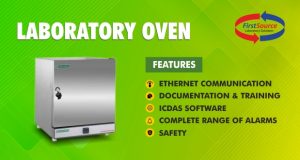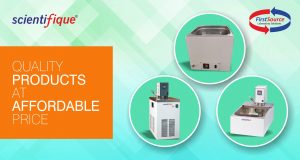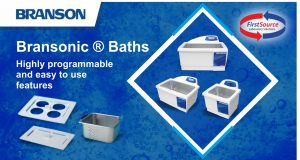Introduction to Ultrasonic:
Ultrasonic cleaner works based on the principle of sound waves. Using a series of transducers sound waves are introduced into the liquid medium. These sound waves when travels through the liquid medium creates cavitation due to compression and rarefaction of the bubbles formed. The microscopic bubbles formed can’t be seen with naked eye as they are very minute and exist only for split second. Partial vacuum is present inside the bubble and as the pressure around the bubble increases the liquid enters and the bubble ruptures rapidly. A jet of liquid created when bubbles collapse, travels at an extremely high rate. Temperature might reach up to 5000°C which is roughly the surface temperature of Sun. Combination of this extremely high temperature and jet velocity provides very intense cleaning in a concentrated area. Compression and rarefaction of the bubbles in a very short duration causes the liquid to absorb heat rapidly and the area cools rapidly. This results in liquid getting warm and not heated up if any parts is introduced into the ultrasonic machine.
Application of Ultrasonic Cleaning:
You need to first determine the need of cleaning and then the level of cleanliness required. There are many tests that can be conducted to measure cleanliness such as particle count, microscopic inspiration, adhesion test and many more.
There are 7 major factors affecting ultrasonic cleaning:
- Time
- Temperature
- Chemistry
- Proximity of the transducer/part fixture design
- Ultrasonic output frequency
- Watts per gallon
- Loading-the volume (configuration) of the part being cleaned
Time:
Time required to clean the parts depends on how dirty it is and how much clean it has to get. Average time for cleaning will be 2-10 mins. Ultrasonic cleaning is not a quick dip-zap process. For some instruments pre-cleaning might be required to prepare them for final cleaning. Other few applications might require more than one ultrasonic cleaning stage to complete the required cleaning. Wash chemicals can be removed by the process of ultrasonic agitated rinsing
Temperature/Chemistry:
Temperature and chemistry go hand in hand. The optimum temperature for ultrasonic cleaning in aqueous solution is at 140°C. High temperature is required for high pH solutions to enhance the synergetic effect of chemistry.
The chemical factors considered for effective aqueous ultrasonic cleaning are:
- Water- hard, soft, DI or distilled
- pH
- Surfactants, wetting agents, dispersants, emulsifies, saponifies
- Optional ingredients, Sequestrants, inhibitors, Buffering agents, defoamers.
Chemicals designed for spray cleaning or rust inhibitors are not suitable for ultrasonic cleaning
Proximity of the Transducer:
The general procedure for ultrasonic cleaning is to place the parts inside the basket and then place basket through the ultrasonic wash, spray rinse, immersion rinse, dry. Sometimes baskets can mask or shadow from the radiating surface of the ultrasonic transducers. Based on the application, the transducers are designed. Some are mounted on the bottom and some on the sides. Automated systems must address the location of the transducers in order to ensure uniformity of cleaning.
Ultrasonic Output Frequency:
Higher the frequency lower is the cavitation formed. Higher frequencies are used for delicate equipment. For general applications, 40KHZ is the base frequency. Lower frequencies are used for large metal masses as large masses absorbs a greater amount of ultrasonic cleaning power.
Watts per Gallon:
Generally, smaller parts require higher watts per gallon to achieve cleanliness of desired level. There is something know as “The Large Tank Phenomenon” which states that there is an inverse relationship between the power density and the tank liquid volume. For 6-30 gallons, 60-85 watts per gallon is required. Similarly for 50-100 gallons, only for about 25-35 watts per gallon is required.
Loading:
The main criteria in loading is that the load weight should be half of the weight of the water volume. This is because a large mass won’t allow for internal cleaning. Even the shape and density of the parts must be considered. It is also good that if you can use 2 smaller loads rather than using one single larger load.
For more Cooling & Heating equipment visit https://www.firstsourcels.com/cooling-heating
Examples of applications for Branson ultrasonic cleaning:
- Laboratory – Removes blood, protein, contaminants
- Industrial – Deep cleaning to remove dirt, waxes, oils from light industrial parts and all kinds like steel, light & nonferrous metals, plastic and glass.
- Electronics – Safe and unwavering cleaning for most delicate parts. Removes flux and contaminants from PC boards, SMDs, quartz crystals, capacitors and many others
- Beyond cleaning – Branson cleaners are extremely versatile and can be used for cell separation, lysis, mixing, emulsification, sample preparation, degassing of liquids.
- 3D Printing – Branson provides ideal way to remove support material from fused deposition modeling 3D-printed parts, Reduction in post processing time, Prototype process.
Versatility of Branson Ultrasonic Bath:
Transducers are the heart of ultrasonicators. It is made up of piezoelectric crystals. These crystals resonate at certain frequency giving ultrasonic waves due to the electrical energy supplied, i.e., they convert electrical energy to acoustic energy. Branson Ultrasonic Bath uses patented transducers which consists of Aluminum horn (radiates the frequency to radiating plate), Radiating plate (transfers the waves to the medium) and Bonding sheet to bind the radiating plate and horn. Bonding sheet will increase the life time of the transducers.

The concept of “No Blind Zone” was introduced in Branson where uniform and spherical waves were produced in the entire tank covering all possible areas in the tank. There are no zones where the waves couldn’t reach. This unique feature provides the best cleaning ever possible.
Sweep control is provided which eliminates standing waves and creates consistency of waves throughout the tank. Frequency is not given continuously hence waves are distributed in uniform way.
As cavitation proceeds foam are produced which act as shock absorbers and resist collapse and tend to remain suspended in the liquid reducing the cleaning efficiency. This problem can be eliminated by degassing which is removal of unwanted air from the liquid. In Branson Ultrasonic bath Degassing can be set for 99 minutes.
Branson Ultrasonic Bath automatically adjusts its power when any other/different kind of input is given. It actively tracks the operating frequency of the bath and immediately the tank’s optimum frequency is regained.
When the cycle gets completed, and no control keys are touched for 15 minutes, the unit goes to sleep mode which accounts to an energy saving green feature.
All these unique points in a single Branson ultrasonic bath is wonderful. FirstSource Laboratory Solutions provides Branson Ultrasonic Bath of various volumes with heating and non-heating types.
 FirstSource Laboratory Solutions Official Blog First Indian Scientific Online Shop
FirstSource Laboratory Solutions Official Blog First Indian Scientific Online Shop



